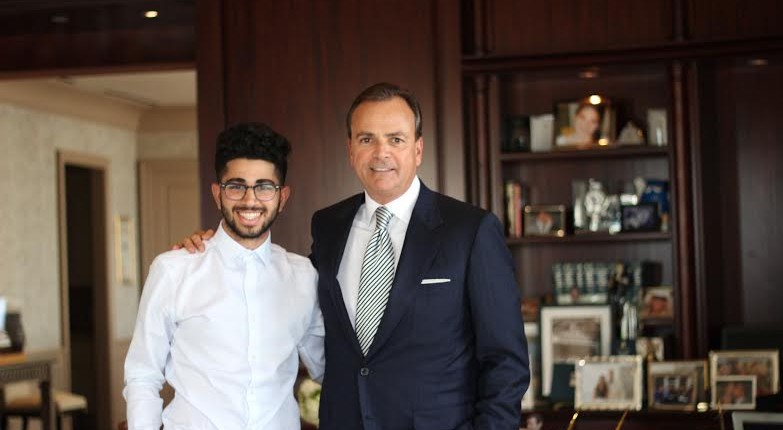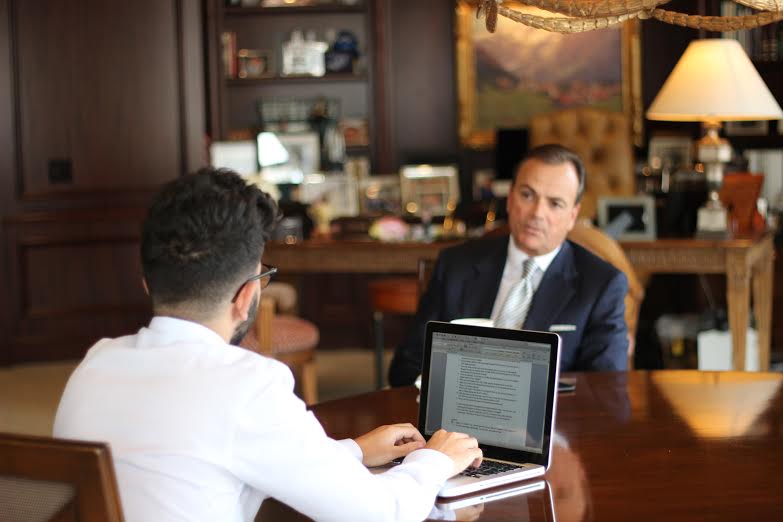Q & A: Rick Caruso and the City of Los Angeles
“Rick Caruso, it’s a pleasure. I’ll be right with you, let me just get settled in my office,” Mr. Caruso said as he shook my hand in the lobby of Caruso Affiliated offices at The Grove in Mid-City Los Angeles.
Stepping out of the elevator, he was returning from a business meeting and was stepping into yet another. With his schedule over-booked for weeks, you would think wear-and-tear would begin to show on the University of Southern California alum, but with a passion and narrowed determination, Mr. Caruso appeared sharp as a nail, strolling down the elegant pathway to his office.
With his office perched atop Michael Kors and across Barneys New York, Caruso is a modern day Willy Wonka. He’s a brilliant visionary, and the impetus behind contemporary Los Angeles. Caruso predicates his life around family. With residential, commercial and mixed-use developments, Caruso has created shopping centers and residences alike that allow you to step into his world and vision. The Grove, The Americana at Brand, The Commons in Calabasas, 8500 Burton Way and several other properties are stitched across the Southland. Mr. Caruso continues to leave his mark on L.A. The Caruso world is bustling and booming and everyone wants a piece of the chocolate bar.
Even with his company and career reaching a crescendo, family comes first and with countless photos and portraits adorning his office, it’s no secret the Caruso family are a loving, close, and tight-knit bunch.
When his offices first confirmed a time to sit-down with Mr. Caruso, it was as if I had found the golden ticket. As I was escorted into his office and we sat down to talk, one thing became increasingly clear: Willy Wonka was opening the gates to his chocolate factory and giving me a glimpse into it.
DT: As many know, you graduated from USC, but could you briefly speak about your background (i.e. where you were born, raised, etc.)?
RC: I was born and raised in Los Angeles. I attended Catholic grammar school, then went to Harvard High School (now Harvard-Westlake). After I graduated from USC, I earned a JD at Pepperdine Law School and began to practice law.
DT: You were appointed by Mayor Tom Bradley as commissioner of the Department of Water and Power. How was your relationship with Bradley?
RC: I actually had no prior relationship with Bradley when I was appointed. Bradley was much older. I had just graduated law school; I was 25 practicing law, and virtually unknown to everyone. A friend had recommended me to the mayor to be appointed and I didn’t meet Mayor Bradley until shortly after that. I loved my time at DWP. I learned a lot and it was an extremely enriching experience.
DT: Did you always desire to enter real estate business? Or did it evolve from your time in civic leader positions?
RC: When I was a lawyer, I was practicing at one of the largest law firms at the time. After some mismanagement, it went bankrupt, but I stayed on. I slowly began to dabble in real estate. I owned a small duplex in Westwood and took care of that for a while, going in on weekends and landscaping and such. My assistant at the time, Laura Phelps, was a trusted aid and she helped out a lot. Caruso Affiliated began to emerge as I was buying up more properties and land to develop.
DT: Your wide array of retail and mixed-use properties has, as some say, fundamentally changed the way Los Angeles shops and eats. Briefly talk about the genesis of The Grove and if possible The Americana at Brand.
RC: Everything didn’t happen overnight, of course. I started small like anyone else. The company was really built organically. I never really wanted to do indoor malls that were sprouting across the L.A. region. Since I controlled the real estate, I wanted to evoke centers that reflected the outdoor squares and piazzas you see in Europe. I wanted to emulate downtown streets. The highest grossing stores in shopping centers aren’t spaces on the third floor inside a mall, they’re the stores on the street that are easily accessible and welcoming. Old town squares are a great way for people to get together and that’s what I wanted to bring to my developments: a way for people to enjoy their day. With the Americana, we began to see the blending of both commercial and residential spaces, which is started to grow for us and proving very popular.
DT: If you could elaborate, do you have any further development plans? Do you have plans to expand outside of Los Angeles?
RC: If we ever find a location or space that is suitable to our tastes, we’re always open to expanding. We have a 5-year plan to double in size and we’re on track to do just that. We’d love to see where we could go in downtown and the Arts District. I want to celebrate neighborhoods and have this sense of community in all parts of L.A. I feel like we missed out on the first wave in downtown, but there are always cycles in real estate. We’ll catch the next bus.
DT: What do you think of the transportation issues facing LA? Is expanding the Metro an effective, permanent solution?
RC: I’ve always felt very strongly about transportation. I never understood why we put people in tunnels in this city. I’d like to see people get out of their cars. We spend too much in our cars and not enough time enjoying what’s around us. Transportation is an important aspect to discuss in L.A.
DT: Other than your own developments, what are some of your favorite shopping centers in LA? What are some of your favorite cafes/restaurants to visit?
RC: I like visiting Larchmont, the Palisades. I’m always all over L.A. and I love everything about this city.
DT: Do you have any advice for students and burgeoning entrepreneurs?
RC: Do what you love. Do what you’re passionate about. If you do that, you’ll never have to work a day in your life. You’ll be outperforming others by doing what you love to do.
Athanasius Georgy is a sophomore majoring in economics. His column, “Food n’ Frame,” runs Tuesdays.
Follow @foodnframe on Instagram.



